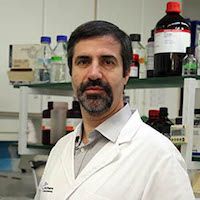Article
Newly Discovered HCV Subtype is Resistant to Antiviral Treatment
Author(s):
A newly discovered hepatitis C virus (HCV) subtype harbors resistance-associated mutations to direct acting antivirals.

Josep Quer, PhD
A newly discovered hepatitis C virus (HCV) genotype 1 subtype harbors multiple resistance-associated mutations that combine to block therapeutic effect of NS5A inhibitor direct-acting antivirals (DAAs).
Josep Quer, PhD, Liver Disease Laboratory-Viral Hepatitis, Vall d'Hebron Institut Recerca-Hospital Universitari, Barcelona and colleagues report the identification of a new HCV genotype 1 subtype isolated from a treatment-naive patient in Equatorial Guinea.
"This novel isolate was identified during routine classification of the HCV virus in patient samples using a high-resolution HCV subtyping method," Quer and colleagues wrote. "Phylogenetic analysis, genetic distance analysis, and sliding window analysis of this genome (GenBank KY348757) clearly demonstrated that our isolate is not a recombinant product of different subtypes and that the genetic distance to the closest accepted reference sequence is higher than 15%."
The HCV isolate is not only unique as a new subtype of genotype 1, but for harboring multiple resistance-associated substitutions (RASs), without apparent exposure to treatment agents which can prompt their manifestation.
Quer and colleagues point out that in subtype 1b, a single L31V or a Y93H substitution emerging in the viral genome has been shown to increase resistance to daclatasvir (Daklinza) by 15-fold and 12-fold, respectively. A virus with both mutations becomes 5425 times more resistant, according to the investigators.
"The most interesting observation from our isolate is that the virus is a natural carrier of L31V and Y93H substitutions in the same genome, as well as H/P58S and E62Q, which have been associated with varying levels of resistance to DAA-based treatments in other subtypes," Quer and colleagues noted. "Hence this subtype may be resistant to NS5A inhibitor drugs."
In an assessment of global epidemiology of HCV subtypes and RASs published in the August issue of Journal of Hepatology, Neeru Bhardwaj, PhD, Research Scientist, Gilead Sciences, Foster City, California, and colleagues emphasize the importance of identifying not only the prevalence of HCV endemic in different parts of the world, but also the presence of RASs.
"The presence of RASs for DAAs targeting NS3, NS5A and NS5B has not been systematically assessed across all HCV subtypes," Bhardwaj and colleagues pointed out.
RASs vary among HCV subtypes, potentially affecting treatment outcomes when they are present. Therefore, Bhardwaj and colleagues recommend that RASs associated with certain HCV subtypes should be considered to optimize DAA therapy.
Quer and colleagues would concur, noting that their finding is only the latest example of some HCV subtypes naturally harboring RASs.
"SVR (sustained virologic response) in HCV-infected patients can vary depending on the patient's viral subtype," Quer and colleagues observed. "Therefore, accurate HCV subtyping is emerging as a key factor when deciding the most suitable DAA combination therapy for affected patients."
The report, "New hepatitis C virus genotype 1 subtype naturally harbouring resistance-associated mutations to NS5A inhibitors," was published in the January issue of the Journal of General Virology.
Click here to sign up for more MD Magazine content and updates.
Related Coverage >>>
Cytomegalovirus Reactivation Patients with HCV Cirrhosis Linked to Cardiovascular Risk
2 Commerce Drive
Cranbury, NJ 08512
All rights reserved.





